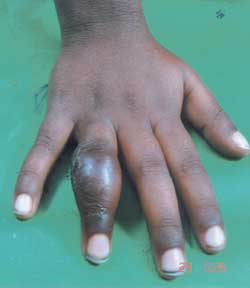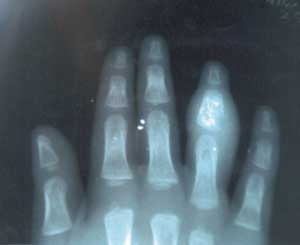|
|
|
Indian Pediatr 2009;46: 431-432 |
 |
Spina Ventosa |
|
JK Singh
Department of Pediatric Surgery, Post Graduate Institute
of Medical Education and Research, Chandigarh 160 012,
E-mail:
[email protected]
|
|
A
7-year old boy presented with a
painless swelling associated with serosanguinous discharge in the left
ring finger for 1
month. He also had cough and fever which was not documented. He had
received multiple courses of antibiotics before coming to us. On
examination, a non-tender, fusiform swelling of the left ring finger
discharging serosanguinous fluid was seen (Fig.1). X-ray
revealed a lytic lesion with little periosteal reaction in the middle
phalanx (Fig.2). X-ray chest revealed bilateral
heterogenous opacities and hilar and paratracheal lymphadenopathy. The
Zeil–Neilson staining of the discharge from the swelling demonstrated acid
fast bacilli.
 |
|
 |
|
Fig. 1 Spindle shaped swelling of the
finger. |
|
Fig. 2 Lytic lesion evident on the radiograph. |
Tubercular infection of metatarsals, metacarpals and
phalanges is usually associated with active pulmonary involvement.
Tubercular infection involving the phalanges results in characteristic
spindle shaped swelling of fingers, a condition known as spina ventosa.
Spina is a latin word for "short bone" and ventosa is a latin
word for "inflated with air". The differential diagnosis of such a
swelling includes syphilis and sickle cell dactylitis. Syphilis can
involve the metaphysis or diaphysis. Syphilis, though rare now-a-days, can
involve bone as a late manifestation of congenital syphilis or as acquired
secondary syphilis in cases of sexual abuse in children. On X-ray,
a zone of sclerosis or periosteal reaction is seen. Sickle cell dactylitis
leads to an acute painful swelling of fingers or toes. Most patients with
sickle cell disease suffer from hemolytic anemia. Vaso-occlusion causes
recurrent episodes of painful crisis. The X-ray shows periosteal
new bone formation followed by medullary resorption, coarsening of
trabeculae and cortical thinning.
|
|
|
 |
|

